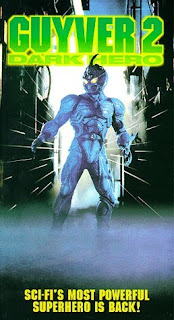The Plot
It's been a year since Sean Barker (David Hayter) bonded with the Guyver, a suit of biomechanical armor of alien origin. With the evil Kronos Corporation and its alien Zoanoid warriors defeated, the armor's urge to battle evil prompts Sean to fight (and oftentimes kill) drug dealers and other criminals. This alienates him from his girlfriend Mizki (Billi Lee) from the first film, who thinks he's going insane and has no time for his "I don't kill, it kills" excuses. Plagued by strange dreams and seeing news on television of "a werewolf attack," Sean sets off for an archaeological dig in Utah overseen by Cori Edwards (Kathy Christopherson) and her father Dr. Marcus Edwards (Stuart Weiss), a pair of renegade scientists investigating things like Bigfoot, crop circles, etc.
Unfortunately, the Kronos Corporation turns out to be involved, as are a bunch of even more skilled and dangerous Zoanoids. Sean is in for the fight of his life...
The Good
*It's a fast-moving and entertaining film--most of the time.
*The script and the dialogue, although they have their issues, represent a significant improvement over the ponderous original. Watching clips of the original on YouTube (they've taken down the full movie since we watched it for Myopia, it seems), it's clear just how clunky the original was and how improved this one is.
*The opening narration is a vast improvement over the original, which had a laughably obnoxious combination of a Star Wars opening crawl ripoff and a ponderous voice-over. Instead we get a quick introduction complete with the image of the Guyver unit flashing and doing its thing and then we cut to a bunch of drug smugglers murdering a security guard.
*Replacing Jack Armstrong with David Hayter in the role of Sean is a vast improvement given how poor Armstrong's acting was in the original film. Even though Mizki is absent for most of the film, Billi Lee is an improvement on Vivian Wu. No unintentional hilarity, hard-to-understand accents, and overdramatic silliness from these two.
*Cori is a much stronger and more driven character than the passive Mizki.
*The fight choreography has improved quite a bit over the original film. In-universe I suppose it's because Sean has had more time to train in martial arts and learn about his armor and these Zoanoids aren't just Kronos's hired gang-banger muscle, but regardless it's much less silly to watch.
*We finally figure out just what Kronos's master plan is besides "conduct grossly unethical medical experiments to turn people into shape-shifting monsters."
The Bad
*There were several parts of the movie, particularly those taking place at night or in the cave system where the archaeological stuff was taking place, that were difficult to see. This might've been because I was watching it on my Kindle at my not-as-well-lit apartment gym (the LA Fitness didn't have that problem), but I don't think I've had that problem before. Something to keep in mind.
*Toward the end of the film there are some parts where it dragged.
*Given all the crap Sean and Mizki went through together in the first film and how they're still together a year afterward despite her knowledge of what Sean does with the armor, I would have liked more acknowledgement of their relationship. Instead Sean moves onto a new love interest relatively quickly--the film seems to take place over the course of only a few days, meaning that he and Mizki broke up at most a week before. It would have been much more interesting if he'd written her a letter or called her from the archaeological site indicating that he had found Zoanoids and she followed him there, with the Kronos Corporation taking note that she's the daughter of the traitor Dr. Segawa. Given the need to keep the run-time concise, throwing in a full-on love triangle might not fly, but Sean just forgets her too quickly.
*Speaking of Sean, in the first half or so of the movie he's really self-absorbed and aggravating. Somebody really needs to read How To Win Friends and Influence People
*Given how the Zoanoid Striker (Jimmie Walker) from the first movie survived and is implied to have defected to the CIA, it would have been amusing to see him again. Although he was easily the weakest of the Kronos Corporation's minions and didn't seem overly dedicated to the cause ("JUST DOING MY JOB!"), he did rough up Mizki and I imagine Sean would not be pleased to see him again. Furthermore, given his outlandishly stereotypical antics in the first film, perhaps fellow African-American Atkins (Christopher Michael) finds him embarrassing and has forced him to get his 'hood tendencies under control, including no longer letting him speak entirely in rap.
(I'm now imagining a scene where Atkins unleashes Striker against Kronos's Zoanoids and he relapses into his ghetto persona in front of Sean. An embarrassed Atkins has to chew him out.)
*The opening credits after the battle with the drug dealers are way too long.
*There are some unintentionally hilarious slow-mo scenes and scenes where Barker is trying to yell. Although Hayter is an improvement over Armstrong, he still has his Narm-ish moments.
The Verdict
An improvement over the original, but still not exactly great cinema. Worth renting or streaming, but not really worth buying. 7.0 out of 10.






